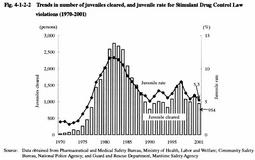| Previous Next Index Image Index Year Selection | |
|
|
2 Drug-related offenses Viewing the trends in the number of juveniles referred for Poisonous and Deleterious Substances Control Law violations since 1972, the year when a partial amendment (in August of the said year) to the law criminalized the act of abusing thinners and other organic solvents or selling such substances in the knowledge that they will be abused, as Fig. 4-1-2-1 shows, the largest number of drug-related offenses come under Poisonous and Deleterious Substances Control Law violations.
Fig. 4-1-2-2 shows the trends in the number of juveniles cleared by the police, and the juvenile rate (the proportion of juveniles to the total number of persons cleared) for Stimulant Drug Control Law violations since 1970. The number of Juveniles cleared for Stimulant Drug Control Law violations increased remarkably in 1980s, recording its highest number in the past in 1982, 2,769 persons, before declining to 954 persons in 2001. The juvenile rate took a downward turn in 1998 and decreased to 5.3% (down 0.7 points from the previous year) in 2001. Fig. 4-1-2-2 Trends in number of juveniles cleared, and juvenile rate for Stimulant Drug Control Law violations (1970-2001) |
